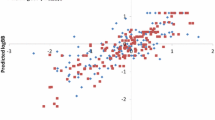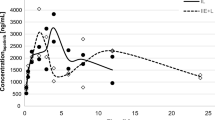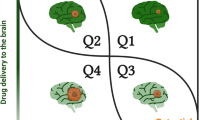Abstract
Purpose
One function of the blood-brain barrier (BBB) is the efflux of xenobiotics by breast cancer resistance protein (BCRP), and inhibition of BCRP can cause unexpected central nervous system toxicity. Despite the importance of BCRP inhibition and the associated risk of BBB penetration in vivo, there has been little investigation of it to date. In this study, inhibition of BCRP-mediated transport was assessed by in vitro assay in the presence of bovine serum albumin (BSA) to change the unbound inhibitor concentrations, and the in vitro-in vivo correlation (IVIVC) at the BBB was evaluated.
Methods and Results
The IC50 values of BCRP inhibitors were determined in vitro with and without BSA and the inhibitors were categorized into two groups. One group of compounds had little risk of inhibiting BCRP because of their low unbound concentrations. In contrast, the other group has the potential to facilitate BBB penetration by inhibiting BCRP. In the IVIVC approach, brain concentrations and the brain-to-plasma ratio were better correlated with the ratio of the unbound plasma concentration at steady-state to the unbound-fraction-adjusted IC50.
Conclusion
We have found a way to obtain a better in vitro-in vivo correlation for BCRP-mediated transport.




Similar content being viewed by others
Abbreviations
- BBB:
-
Blood-brain barrier
- BSA:
-
Bovine serum albumin
- BCRP (ABCG2):
-
Breast cancer resistance protein
- Ct :
-
Total concentration
- Cu :
-
Unbound concentration
- DMSO:
-
Dimethyl sulfoxide
- ER:
-
Efflux ratio
- f u,1%BSA :
-
Unbound fraction with 1% BSA
- f u,p :
-
Unbound fraction in plasma
- HBSS:
-
Hanks’ Balanced Salt Solution
- HEPES:
-
2-[4-(2-hydroxyethyl)piperazin-1-yl]ethanesulfonic acid
- HPLC:
-
High-performance liquid chromatography
- I ss,total :
-
Total plasma concentration at steady-state
- I ss,unbound :
-
Unbound plasma concentration at steady-state
- IVIVC:
-
In vitro-in vivo correlation
- K i :
-
Inhibition constant
- K p,brain :
-
Brain-to-plasma ratio
- MDCKII-BCRP:
-
Madin–Darby canine kidney cells transfected with human BCRP gene
- P app :
-
Apparent permeability coefficient
- P-gp (ABCB1):
-
P-glycoprotein
- RA:
-
Residual activity (% of control)
- TB:
-
Transport buffer
- TB-BSA:
-
Transport buffer with BSA
- UPLC:
-
Ultra-performance liquid chromatography
References
Schinkel AH. P-glycoprotein, a gatekeeper in the blood-brain barrier. Adv Drug Deliv Rev. 1999;36(2–3):179–94.
Cooray HC, Blackmore CG, Maskell L, Barrand MA. Localisation of breast cancer resistance protein in microvessel endothelium of human brain. Neuroreport. 2002;13(16):2059–63.
Golden PL, Pollack GM. Blood-brain barrier efflux transport. J Pharm Sci. 2003;92(9):1739–53.
Gampa G, Kim M, Cook-Rostie N, Laramy JK, Sarkaria JN, Paradiso L, et al. Brain distribution of a novel MEK inhibitor E6201: implications in the treatment of melanoma brain metastases. Drug Metab Dispos. 2018;46(5):658–66.
Roberts LM, Black DS, Raman C, Woodford K, Zhou M, Haggerty JE, et al. Subcellular localization of transporters along the rat blood–brain barrier and blood–cerebral-spinal fluid barrier by in vivo biotinylation. Neuroscience. 2008;155(2):423–38.
Lee Y, Jana S, Acharya G, Lee CH. Computational analysis and predictive modeling of polymorph descriptors. Chem Cent J. 2013;7(1):1–14.
Nicolas J, De Lange ECM. Mind the gaps: ontogeny of human brain P-gp and its impact on drug toxicity. AAPS J. 2019;21(4):67.
Sadeque A, Wandel C, He H, Shah S, Wood AJ. Increased drug delivery to the brain by P-glycoprotein inhibition. Clin Pharmacol Ther. 2000;68(3):231–7.
Kodaira H, Kusuhara H, Ushiki J, Fuse E, Sugiyama Y. Kinetic analysis of the cooperation of P-glycoprotein (P-gp/Abcb1) and breast cancer resistance protein (Bcrp/Abcg2) in limiting the brain and testis penetration of erlotinib, flavopiridol, and mitoxantrone. J Pharmacol Exp Ther. 2010;333(3):788–96.
Uchida Y, Ohtsuki S, Katsukura Y, Ikeda C, Suzuki T, Kamiie J, et al. Quantitative targeted absolute proteomics of human blood–brain barrier transporters and receptors. J Neurochem. 2011;117(2):333–45.
Kruijtzer CMF, Beijnen JH, Rosing H, Hunink WWTB, Schot M, Jewell RC, et al. Increased oral bioavailability of topotecan in combination with the breast cancer resistance protein and P-glycoprotein inhibitor GF120918. J Clin Oncol. 2002;20(13):2943–50.
Vaalburg W, Hendrikse N, Elsinga P, Bart J, Vanwaarde A. P-glycoprotein activity and biological response. Toxicol Appl Pharmacol. 2005;207(2):257–60.
Luurtsema G, Elsinga P, Dierckx R, Boellaard R, van Waarde A. PET tracers for imaging of ABC transporters at the blood-brain barrier: principles and strategies. Curr Pharm Des. 2016;22(38):5779–85.
Lee YJ, Kusuhara H, Jonker JW, Schinkel AH, Sugiyama Y. Investigation of efflux transport of dehydroepiandrosterone sulfate and mitoxantrone at the mouse blood-brain barrier: a minor role of breast cancer resistance protein. J Pharmacol Exp Ther. 2005;312(1):44–52.
Asakawa C, Ogawa M, Kumata K, Fujinaga M, Kato K, Yamasaki T, et al. [11C]Sorafenib: radiosynthesis and preliminary PET study of brain uptake in P-gp/Bcrp knockout mice. Bioorg Med Chem Lett. 2011;21(8):2220–3.
Vlaming MLH, Läppchen T, Jansen HT, Kivits S, Driel AV, Steeg EVD, et al. PET-CT imaging with [18F]-gefitinib to measure Abcb1a/1b (P-gp) and Abcg2 (Bcrp1) mediated drug–drug interactions at the murine blood–brain barrier. Nucl Med Biol. 2015;42(11):833–41.
Sugimoto H, Hirabayashi H, Kimura Y, Furuta A, Amano N. Quantitative investigation of the impact of P-glycoprotein inhibition on drug transport across blood-brain barrier in rats. Drug Metab Dispos. 2011;39(1):8–14.
Nagasaka Y, Oda K, Iwatsubo T, Kawamura A, Usui T. Effects of aripiprazole and its active metabolite dehydroaripiprazole on the activities of drug efflux transporters expressed both in the intestine and at the blood-brain barrier. Biopharm Drug Dispos. 2012;33(6):304–15.
Giacomini KM, Huang S, Tweedie DJ, Benet LZ. Membrane transporters in drug development. The international transporter consortium. Nat Rev Drug Discov. 2010;9(3):215–36.
Hsiao P, Bui T, Ho RJY, Unadkat JD. In vitro-to-in vivo prediction of P-glycoprotein-based drug interactions at the human and rodent blood-brain barrier. Drug Metab Dispos. 2008;36(3):481–4.
Kikuchi R, Peterkin VC, Chiou WJ, de Morais SM, Bow DAJ. Validation of a total IC50 method which enables in vitro assessment of transporter inhibition under semi-physiological conditions. Xenobiotica. 2017;47(9):825–32.
Riccardi K, Lin J, Li Z, Niosi M, Ryu S, Hua W, et al. Novel method to predict in vivo liver-to-plasma Kpuu for OATP substrates using suspension hepatocytes. Drug Metab Dispos. 2017;45(5):576–80.
Shah D, Paruchury S, Matta M, Chowan G, Subramanian M, Saxena A, et al. A systematic evaluation of solubility enhancing excipients to enable the generation of permeability data for poorly soluble compounds in Caco-2 model. Drug Metab Lett. 2014;8(2):109–18.
Miyauchi S, Masuda M, Kim SJ, Tanaka Y, Lee KR, Iwakado S, et al. The phenomenon of albumin-mediated hepatic uptake of organic anion transport polypeptide substrates: prediction of the in vivo uptake clearance from the in vitro uptake by isolated hepatocytes using a facilitated-dissociation model. Drug Metab Dispos. 2018;46(3):259–67.
Bowman CM, Benet LZ. An examination of protein binding and protein-facilitated uptake relating to in vitro-in vivo extrapolation. Eur J Pharm Sci. 2018;123:502–14.
Poulin P, Haddad S. Extrapolation of the hepatic clearance of drugs in the absence of albumin in vitro to that in the presence of albumin in vivo: comparative assessement of 2 extrapolation models based on the albumin-mediated hepatic uptake theory and limitations and mechanistic insights. J Pharm Sci. 2018;107(7):1791–7.
Chearwae W, Shukla S, Limtrakul P, Ambudkar SV. Modulation of the function of the multidrug resistance-linked ATP-binding cassette transporter ABCG2 by the cancer chemopreventive agent curcumin. Mol Cancer Ther. 2006;5(8):1995–2006.
Murakami M, Ohnuma S, Fukuda M, Chufan EE, Kudoh K, Kanehara K, et al. Synthetic analogs of curcumin modulate the function of multidrug resistance–linked ATP-binding cassette transporter ABCG2. Drug Metab Dispos. 2017;45(11):1166–77.
Elsby R, Martin P, Surry D, Sharma P, Fenner K. Solitary inhibition of the breast cancer resistance protein efflux transporter results in a clinically significant drug-drug interaction with rosuvastatin by causing up to a 2-fold increase in statin exposure. Drug Metab Dispos. 2016;44(3):398–408.
Braselmann S, Taylor V, Zhao H, Wang S, Sylvain C, Baluom M, et al. R406, an orally available spleen tyrosine kinase inhibitor blocks fc receptor signaling and reduces immune complex-mediated inflammation. J Pharmacol Exp Ther. 2006;319(3):998–1008.
Kalvass JC, Pollack GM. Kinetic considerations for the quantitative assessment of efflux activity and inhibition: implications for understanding and predicting the effects of efflux inhibition. Pharm Res. 2007;24(2):265–76.
Acknowledgements and Disclosures
We thank Dr. Gerald E. Smyth, Discovery Research Laboratories in Tsukuba, Nippon Shinyaku Co., Ltd., for his help with the manuscript.
Author information
Authors and Affiliations
Corresponding author
Ethics declarations
Conflict of Interest
The authors declare no competing financial interest. This study was supported by Nippon Shinyaku Co., Ltd.
Additional information
Publisher’s Note
Springer Nature remains neutral with regard to jurisdictional claims in published maps and institutional affiliations.
Electronic supplementary material
ESM 1
(DOCX 253 kb)
Rights and permissions
About this article
Cite this article
Imai, S., Arai, T., Yamada, T. et al. Improved In Vitro-In Vivo Correlation by Using the Unbound-Fraction-Adjusted IC50 for Breast Cancer Resistance Protein Inhibition. Pharm Res 37, 230 (2020). https://doi.org/10.1007/s11095-020-02954-1
Received:
Accepted:
Published:
DOI: https://doi.org/10.1007/s11095-020-02954-1




